Hovercraft



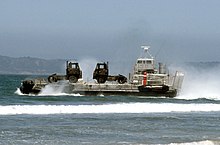
A hovercraft (pl.: hovercraft
Hovercraft use blowers to produce a large volume of air below the hull, or air cushion, that is slightly above atmospheric pressure. The pressure difference between the higher-pressure air below the hull and lower pressure ambient air above it produces lift, which causes the hull to float above the running surface. For stability reasons, the air is typically blown through slots or holes around the outside of a disk- or oval-shaped platform, giving most hovercraft a characteristic rounded-rectangle shape.
The first practical design for hovercraft was derived from a British invention in the 1950s. They are now used throughout the world as specialised transports in disaster relief, coastguard, military and survey applications, as well as for sport or passenger service. Very large versions have been used to transport hundreds of people and vehicles across the English Channel, whilst others have military applications used to transport tanks, soldiers and large equipment in hostile environments and terrain. Decline in public demand meant that as of 2023[update], the only year-round public hovercraft service in the world still in operation serves between the Isle of Wight and Southsea in the UK.[3][4]
Although now a generic term for the type of craft, the name Hovercraft itself was a trademark owned by Saunders-Roe (later British Hovercraft Corporation (BHC), then Westland), hence other manufacturers' use of alternative names to describe the vehicles.
History
Early efforts
There have been many attempts to understand the principles of high air pressure below hulls and wings. Hovercraft are unique in that they can lift themselves while still, differing from
The first mention, in the historical record of the concepts behind surface-effect vehicles, to use the term hovering was by Swedish scientist Emanuel Swedenborg in 1716.[5]
The shipbuilder John Isaac Thornycroft patented an early design for an air cushion ship / hovercraft in the 1870s, but suitable, powerful, engines were not available until the 20th century.[6]

In 1915, the Austrian
The theoretical grounds for motion over an air layer were constructed by
In 1929, Andrew Kucher of Ford began experimenting with the Levapad concept, metal disks with pressurized air blown through a hole in the centre. Levapads do not offer stability on their own. Several must be used together to support a load above them. Lacking a skirt, the pads had to remain very close to the running surface. He initially imagined these being used in place of casters and wheels in factories and warehouses, where the concrete floors offered the smoothness required for operation. By the 1950s, Ford showed a number of toy models of cars using the system, but mainly proposed its use as a replacement for wheels on trains, with the Levapads running close to the surface of existing rails.[10]
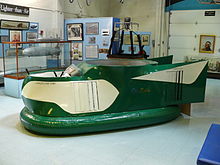
In 1931, Finnish aero engineer Toivo J. Kaario began designing a developed version of a vessel using an air cushion and built a prototype Pintaliitäjä ('Surface Glider'), in 1937.[11] His design included the modern features of a lift engine blowing air into a flexible envelope for lift. Kaario's efforts were followed closely in the Soviet Union by Vladimir Levkov, who returned to the solid-sided design of the Versuchsgleitboot. Levkov designed and built a number of similar craft during the 1930s, and his L-5 fast-attack boat reached 70 knots (130 km/h) in testing. However, the start of World War II put an end to his development work.[12][13]
During World War II, an American engineer, Charles Fletcher, invented a walled air cushion vehicle, the Glidemobile. Because the project was classified by the U.S. government, Fletcher could not file a patent.[14]
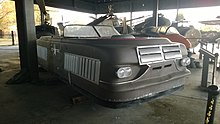
In April 1958,
In 1959, Ford displayed a hovercraft concept car, the Ford Levacar Mach I. [20] [21]
In August 1961,
Christopher Cockerell
The idea of the modern hovercraft is most often associated with Christopher Cockerell, a British mechanical engineer. Cockerell's group was the first to develop the use of a ring of air for maintaining the cushion, the first to develop a successful skirt, and the first to demonstrate a practical vehicle in continued use. A memorial to Cockerell's first design stands in the village of Somerleyton.
Cockerell came across the key concept in his design when studying the ring of airflow when high-pressure air was blown into the annular area between two concentric tin cans (one coffee and the other from cat food) and a hairdryer. This produced a ring of airflow, as expected, but he noticed an unexpected benefit as well; the sheet of fast-moving air presented a sort of physical barrier to the air on either side of it. This effect, which he called the "momentum curtain", could be used to trap high-pressure air in the area inside the curtain, producing a high-pressure plenum that earlier examples had to build up with considerably more airflow. In theory, only a small amount of active airflow would be needed to create lift and much less than a design that relied only on the momentum of the air to provide lift, like a helicopter. In terms of power, a hovercraft would only need between one quarter to one half of the power required by a helicopter.
Cockerell built and tested several models of his hovercraft design in Somerleyton, Suffolk, during the early 1950s. The design featured an engine mounted to blow from the front of the craft into a space below it, combining both lift and propulsion. He demonstrated the model flying over many Whitehall carpets in front of various government experts and ministers, and the design was subsequently put on the secret list. In spite of tireless efforts to arrange funding, no branch of the military was interested, as he later joked, "The Navy said it was a plane not a boat; the RAF said it was a boat not a plane; and the Army were 'plain not interested'."[22]
SR.N1
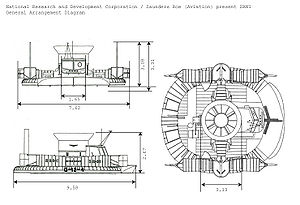
This lack of military interest meant that there was no reason to keep the concept secret, and it was declassified. Cockerell was finally able to convince the National Research Development Corporation to fund development of a full-scale model. In 1958, the NRDC placed a contract with Saunders-Roe for the development of what would become the SR.N1, short for "Saunders-Roe, Nautical 1".
The SR.N1 was powered by a 450 hp Alvis Leonides engine powering a vertical fan in the middle of the craft. In addition to providing the lift air, a portion of the airflow was bled off into two channels on either side of the craft, which could be directed to provide thrust. In normal operation this extra airflow was directed rearward for forward thrust and blew over two large vertical rudders that provided directional control. For low-speed manoeuvrability, the extra thrust could be directed fore or aft, differentially for rotation.
The SR.N1 made its first hover on 11 June 1959, and made its famed successful crossing of the English Channel on 25 July 1959. In December 1959, the Duke of Edinburgh visited Saunders-Roe at East Cowes and persuaded the chief test-pilot, Commander Peter Lamb, to allow him to take over the SR.N1's controls. He flew the SR.N1 so fast that he was asked to slow down a little. On examination of the craft afterwards, it was found that she had been dished in the bow due to excessive speed, damage that was never allowed to be repaired, and was from then on affectionately referred to as the 'Royal Dent'.[23]
Skirts and other improvements
Testing quickly demonstrated that the idea of using a single engine to provide air for both the lift curtain and forward flight required too many trade-offs. A Blackburn Marboré turbojet for forward thrust and two large vertical rudders for directional control were added, producing the SR.N1 Mk II. A further upgrade with the Armstrong Siddeley Viper produced the Mk III. Further modifications, especially the addition of pointed nose and stern areas, produced the Mk IV.
Although the SR.N1 was successful as a testbed, the design hovered too close to the surface to be practical; at 9 inches (23 cm) even small waves would hit the bow. The solution was offered by Cecil Latimer-Needham, following a suggestion made by his business partner Arthur Ord-Hume. In 1958, he suggested the use of two rings of rubber to produce a double-walled extension of the vents in the lower fuselage. When air was blown into the space between the sheets it exited the bottom of the skirt in the same way it formerly exited the bottom of the fuselage, re-creating the same momentum curtain, but this time at some distance from the bottom of the craft.
Latimer-Needham and Cockerell devised a 4 feet (1.2 m) high skirt design, which was fitted to the SR.N1 to produce the Mk V,[24] displaying hugely improved performance, with the ability to climb over obstacles almost as high as the skirt. In October 1961, Latimer-Needham sold his skirt patents to Westland, who had recently taken over Saunders Roe's interest in the hovercraft.[25] Experiments with the skirt design demonstrated a problem; it was originally expected that pressure applied to the outside of the skirt would bend it inward, and the now-displaced airflow would cause it to pop back out. What actually happened is that the slight narrowing of the distance between the walls resulted in less airflow, which in turn led to more air loss under that section of the skirt. The fuselage above this area would drop due to the loss of lift at that point, and this led to further pressure on the skirt.
After considerable experimentation, Denys Bliss at Hovercraft Development Ltd. found the solution to this problem. Instead of using two separate rubber sheets to form the skirt, a single sheet of rubber was bent into a U shape to provide both sides, with slots cut into the bottom of the U forming the annular vent. When deforming pressure was applied to the outside of this design, air pressure in the rest of the skirt forced the inner wall to move in as well, keeping the channel open. Although there was some deformation of the curtain, the airflow within the skirt was maintained and the lift remained relatively steady. Over time, this design evolved into individual extensions over the bottom of the slots in the skirt, known as "fingers".
Commercialisation
Through these improvements, the hovercraft became an effective transport system for high-speed service on water and land, leading to widespread developments for military vehicles, search and rescue, and commercial operations. By 1962, many UK aviation and shipbuilding firms were working on hovercraft designs, including Saunders Roe/Westland, Vickers-Armstrong, William Denny, Britten-Norman and Folland.[26] Small-scale ferry service started as early as 1962 with the launch of the Vickers-Armstrong VA-3. With the introduction of the 254 passenger and 30 car carrying SR.N4 cross-channel ferry by Hoverlloyd and Seaspeed in 1968, hovercraft had developed into useful commercial craft.
Another major pioneering effort of the early hovercraft era was carried out by Jean Bertin's firm in France. Bertin was an advocate of the "multi-skirt" approach, which used a number of smaller cylindrical skirts instead of one large one in order to avoid the problems noted above. During the early 1960s he developed a series of prototype designs, which he called "terraplanes" if they were aimed for land use, and "naviplanes" for water. The best known of these designs was the N500 Naviplane, built for Seaspeed by the Société d'Etude et de Développement des Aéroglisseurs Marins (SEDAM). The N500 could carry 400 passengers, 55 cars and five buses. It set a speed record between Boulogne and Dover of 74 kn (137 km/h). It was rejected by its operators, who claimed that it was unreliable.[27]
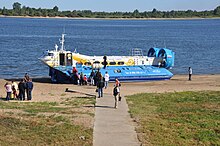
Another discovery was that the total amount of air needed to lift the craft was a function of the roughness of the surface over which it travelled. On flat surfaces, like pavement, the required air pressure was so low that hovercraft were able to compete in energy terms with conventional systems like steel wheels. However, the hovercraft lift system acted as both a lift and a very effective suspension, and thus it naturally lent itself to high-speed use where conventional suspension systems were considered too complex. This led to a variety of "

- Propellers
- Air
- Fan
- Flexible skirt
By the early 1970s, the basic concept had been well developed, and the hovercraft had found a number of niche roles where its combination of features were advantageous. Today, they are found primarily in military use for amphibious operations, search-and-rescue vehicles in shallow water, and sporting vehicles.
Design
Hovercraft can be powered by one or more engines. Smaller craft, such as the SR.N6, usually have one engine with the drive split through a gearbox. On vehicles with several engines, one usually drives the fan (or impeller), which is responsible for lifting the vehicle by forcing high pressure air under the craft. The air inflates the "skirt" under the vehicle, causing it to rise above the surface. Additional engines provide thrust in order to propel the craft. Some hovercraft use ducting to allow one engine to perform both tasks by directing some of the air to the skirt, the rest of the air passing out of the back to push the craft forward.
Uses
Commercial
The British aircraft and marine engineering company Saunders-Roe built the first practical human-carrying hovercraft for the National Research Development Corporation, the SR.N1, which carried out several test programmes in 1959 to 1961 (the first public demonstration was in 1959), including a cross-channel test run in July 1959, piloted by Peter "Sheepy" Lamb, an ex-naval test pilot and the chief test pilot at Saunders Roe. Christopher Cockerell was on board, and the flight took place on the 50th anniversary of Louis Blériot's first aerial crossing.[28]
The SR.N1 was driven by expelled air, powered by a single piston engine. Demonstrated at the Farnborough Airshow in 1960,[28] it was shown that this simple craft can carry a load of up to 12 marines with their equipment as well as the pilot and co-pilot with only a slight reduction in hover height proportional to the load carried. The SR.N1 did not have any skirt, using instead the peripheral air principle that Cockerell had patented. It was later found that the craft's hover height was improved by the addition of a skirt of flexible fabric or rubber around the hovering surface to contain the air. The skirt was an independent invention made by a Royal Navy officer, C.H. Latimer-Needham, who sold his idea to Westland (by then the parent of Saunders-Roe's helicopter and hovercraft interests), and who worked with Cockerell to develop the idea further.
The first passenger-carrying hovercraft to enter service was the
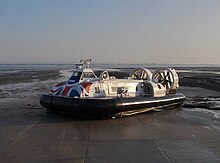
During the 1960s, Saunders-Roe developed several larger designs that could carry passengers, including the
Operations by
In 1966, two cross-channel passenger hovercraft services were inaugurated using SR.N6 hovercraft. Hoverlloyd ran services from Ramsgate Harbour, England, to Calais, France, and Townsend Ferries also started a service to Calais from Dover, which was soon superseded by that of Seaspeed.
As well as Saunders-Roe and Vickers (which combined in 1966 to form the British Hovercraft Corporation (BHC)), other commercial craft were developed during the 1960s in the UK by

The world's first car-carrying hovercraft was made in 1968, the BHC Mountbatten class (SR.N4) models, each powered by four Bristol Proteus turboshaft engines. These were both used by rival operators Hoverlloyd and Seaspeed (which joined to form Hoverspeed in 1981) to operate regular car and passenger carrying services across the English Channel. Hoverlloyd operated from Ramsgate, where a special hoverport had been built at Pegwell Bay, to Calais. Seaspeed operated from Dover, England, to Calais and Boulogne in France. The first SR.N4 had a capacity of 254 passengers and 30 cars, and a top speed of 83 kn (154 km/h). The channel crossing took around 30 minutes and was run like an airline with flight numbers. The later SR.N4 Mk.III had a capacity of 418 passengers and 60 cars. These were later joined by the French-built SEDAM N500 Naviplane with a capacity of 385 passengers and 45 cars; only one entered service and was used intermittently for a few years on the cross-channel service until returned to SNCF in 1983. The service ceased on 1 October 2000 after 32 years, due to competition with traditional ferries, catamarans, the disappearance of duty-free shopping within the EU, the advancing age of the SR.N4 hovercraft, and the opening of the Channel Tunnel.[32]
The commercial success of hovercraft suffered from rapid rises in fuel prices during the late 1960s and 1970s, following conflict in the Middle East. Alternative over-water vehicles, such as wave-piercing catamarans (marketed as the
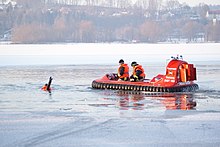
Civilian non-commercial

In Finland, small hovercraft are widely used in maritime rescue and during the rasputitsa ("mud season") as archipelago liaison vehicles. In England, hovercraft of the Burnham-on-Sea Area Rescue Boat (BARB) are used to rescue people from thick mud in Bridgwater Bay. Avon Fire and Rescue Service became the first Local Authority fire service in the UK to operate a hovercraft. It is used to rescue people from thick mud in the Weston-super-Mare area and during times of inland flooding. A Griffon rescue hovercraft has been in use for a number of years with the Airport Fire Service at Dundee Airport in Scotland. It is used in the event of an aircraft ditching in the Tay estuary. Numerous fire departments around the US/Canadian Great Lakes operate hovercraft for water and ice rescues, often of ice fisherman stranded when ice breaks off from shore. The Canadian Coast Guard uses hovercraft to break light ice.[34][35]

In October 2008, The Red Cross commenced a flood-rescue service hovercraft based in Inverness, Scotland.[36] Gloucestershire Fire and Rescue Service received two flood-rescue hovercraft donated by Severn Trent Water following the 2007 UK floods.[37]
Since 2006, hovercraft have been used in aid in Madagascar by HoverAid, an international NGO who use the hovercraft to reach the most remote places on the island.[38]
The Scandinavian airline
In 1998, the US Postal Service began using the British built

In 2006, Kvichak Marine Industries of
An experimental service was operated in Scotland across the
Since the Channel routes abandoned hovercraft, and pending any reintroduction on the Scottish route, the United Kingdom's only public hovercraft service is that operated by Hovertravel between Southsea (Portsmouth) and Ryde on the Isle of Wight.[citation needed]
From the 1960s, several commercial lines were operated in Japan, without much success. In Japan the last commercial line had linked
Hovercraft are still manufactured in the UK, near to where they were first conceived and tested, on the Isle of Wight.[citation needed] They can also be chartered for a wide variety of uses including inspections of shallow bed offshore wind farms and VIP or passenger use. A typical vessel would be a Tiger IV or a Griffon. They are light, fast, road transportable and very adaptable with the unique feature of minimising damage to environments.
Military
China

The People's Army Navy of
Finland
The
Iran
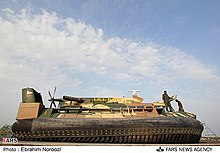
The
Russia

The
United Kingdom
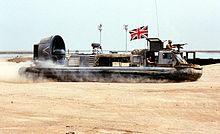
The first application of the hovercraft for military use was by the
United States

During the 1960s,
Experience led to the proposed Bell SK-10, which was the basis for the
Recreational/sport
Small commercially manufactured, kit or plan-built hovercraft are increasingly being used for recreational purposes, such as inland racing and cruising on inland lakes and rivers, marshy areas, estuaries and inshore coastal waters.[50]
The Hovercraft Cruising Club[51] supports the use of hovercraft for cruising in coastal and inland waterways, lakes and lochs.
The Hovercraft Club of Great Britain, founded in 1966, regularly organizes inland and coastal hovercraft race events at various venues across the United Kingdom.[52] Similar events are also held in Europe and the US.[53][54]
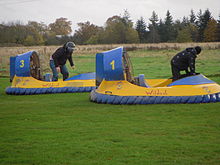
In August 2010, the Hovercraft Club of Great Britain hosted the World Hovercraft Championships at Towcester Racecourse,[55] followed by the 2016 World Hovercraft Championships at the West Midlands Water Ski Centre in Tamworth.
The World Hovercraft Championships are run under the auspices of the World Hovercraft Federation.[56] So far the World Hovercraft Championships had been hosted by France: 1993 in Verneuil, 1997 in Lucon, 2006 at the Lac de Tolerme; Germany: 1987 in Bad Karlshafen, 2004 in Berlin, 2012 and 2018 in Saalburg; Portugal: 1995 in Peso de la Regua; Sweden: 2008 and 2022 at Flottbro Ski Centre in Huddinge; UK 1991 and 2000 at Weston Parc; US: 1989 in Troy (Ohio), 2002 in Terre Haute. The 2020 World Hovercraft Championships had to be postponed to 2022 due to restriction caused by the Covid-19 outbreak.
Apart from the craft designed as "racing hovercraft", which are often only suitable for racing, there is another form of small personal hovercraft for leisure use, often referred to as cruising hovercraft, capable of carrying up to four people. Just like their full size counterparts, the ability of these small personal hovercraft to safely cross all types of terrain, (e.g. water, sandbanks, swamps, ice, etc.) and reach places often inaccessible by any other type of craft, makes them suitable for a number of roles, such as survey work and patrol and rescue duties in addition to personal leisure use. Increasingly, these craft are being used as yacht tenders, enabling yacht owners and guests to travel from a waiting yacht to, for example, a secluded beach. In this role, small hovercraft can offer a more entertaining alternative to the usual small boat and can be a rival for the jet-ski. The excitement of a personal hovercraft can now be enjoyed at "experience days", which are popular with families, friends and those in business, who often see them as team building exercises. This level of interest has naturally led to a hovercraft rental sector and numerous manufacturers of small, ready built designs of personal hovercraft to serve the need.[57]
Other uses
Hoverbarge
A real benefit of air cushion vehicles in moving heavy loads over difficult terrain, such as swamps, was overlooked by the excitement of the British Government funding to develop high-speed hovercraft. It was not until the early 1970s that the technology was used for moving a modular marine barge with a dragline on board for use over soft reclaimed land.
Mackace (Mackley Air Cushion Equipment), now known as Hovertrans, produced a number of successful Hoverbarges, such as the 250 ton payload "Sea Pearl", which operated in Abu Dhabi, and the twin 160 ton payload "Yukon Princesses", which ferried trucks across the Yukon River to aid the pipeline build. Hoverbarges are still in operation today. In 2006, Hovertrans (formed by the original managers of Mackace) launched a 330-ton payload drilling barge in the swamps of Suriname.[58]
The Hoverbarge technology is somewhat different from high-speed hovercraft, which has traditionally been constructed using aircraft technology. The initial concept of the air cushion barge has always been to provide a low-tech amphibious solution for accessing construction sites using typical equipment found in this area, such as diesel engines, ventilating fans, winches and marine equipment. The load to move a 200 ton payload ACV barge at 5 kn (9.3 km/h) would only be 5 tons. The skirt and air distribution design on high-speed craft again is more complex, as they have to cope with the air cushion being washed out by a wave and wave impact. The slow speed and large mono chamber of the hover barge actually helps reduce the effect of wave action, giving a very smooth ride.
The low pull force enabled a Boeing 107 helicopter to pull a hoverbarge across snow, ice and water in 1982.[59][60]
Hovertrains
Several attempts have been made to adopt air cushion technology for use in fixed track systems, in order to use the lower frictional forces for delivering high speeds. The most advanced example of this was the Aérotrain, an experimental high speed hovertrain built and operated in France between 1965 and 1977. The project was abandoned in 1977 due to lack of funding, the death of its lead engineer and the adoption of the TGV by the French government as its high-speed ground transport solution.
A test track for a tracked hovercraft system was built at
After the Cambridge project was abandoned due to financial constraints, parts of the project were picked up by the engineering firm
At the other end of the speed spectrum, the U-Bahn Serfaus has been in continuous operation since 1985. This is an unusual underground air cushion funicular rapid transit system, situated in the Austrian ski resort of Serfaus. Only 1,280 m (4,200 ft) long, the line reaches a maximum speed of 25 mph (40 km/h). A similar system also exists in Narita International Airport near Tokyo, Japan.
In the late 1960s and early 1970s, the U.S. Department of Transport's Urban Mass Transit Administration (UMTA) funded several hovertrain projects, which were known as Tracked Air Cushion Vehicles or TACVs. They were also known as Aerotrains since one of the builders had a licence from Bertin's Aerotrain company. Three separate projects were funded. Research and development was carried out by Rohr, Inc., Garrett AiResearch and Grumman. UMTA built an extensive test site in Pueblo, Colorado, with different types of tracks for the different technologies used by the prototype contractors. They managed to build prototypes and do a few test runs before the funding was cut.
Heavy haulage
From the 1960s to 1980s, heavy haulers in the
The transformers were loaded into the girder frame of the hydraulic modular trailer with axle lines in front and behind of the transformer, which made it possible to keep the transformer as low as possible to the ground to negotiate obstacles on the route. Air cushions were mounted under the girder frame's surface and were operated by a compressor vehicle which was a customized Commer 16-ton maxiload provided by CEGB. The vehicle was loaded with 4 air compressors powered by a Rolls-Royce engine producing 235 bhp. While negotiating a bridge the air cushions were inflated and that reduced the stress tremendously on the bridge. Without this technology the government would have had to rebuild the bridges which was not feasible just to carry a small number of loads.[65]
Non-transportation
The
The Flymo is an air-cushion lawn mower that uses a fan on the cutter blade to provide lift. This allows it to be moved in any direction, and provides double-duty as a mulcher.
The
Features
Advantages
- Terrain-independence - crossing beachfronts and slopes up to 40 degrees
- All-season capability - frozen or flowing rivers no object
- Speed
- Flexibility, due to low surface friction
Disadvantages
- Engine noise emissions
- Initial costs
- Proneness to contrary winds
- Skirt wear and tear
Preservation
The Hovercraft Museum at Lee-on-the-Solent, Hampshire, England, houses the world's largest collection of hovercraft designs, including some of the earliest and largest. Much of the collection is housed within the retired SR.N4 hovercraft Princess Anne. She is the last of her kind in the world. There are many hovercraft in the museum but all are non-operational.
As of 2023[update], Hovercraft continue in use between Ryde on the Isle of Wight and Southsea on the English mainland. The service, operated by Hovertravel, schedules up to three crossings each hour, and provides the fastest way of getting on or off the island. Large passenger-hovercraft are still manufactured on the Isle of Wight.
Records

- World's Largest Civil Hovercraft[66] – The BHC SR.N4 Mk.III, at 56.4 m (185 ft) length and 310 metric tons (305 long tons) weight, can accommodate 418 passengers and 60 cars.
- World's largest military hovercraft – The Russian Greek Navy.
- Mountbatten class hovercraftSR.N4 Mk.III on 14 September 1995
- World Hovercraft Speed Record[67] – 137.4 km/h (85.38 mph or 74.19 knots). Bob Windt (USA) at World Hovercraft Championships, Rio Douro River, Peso de Regua, Portugal on 18 September 1995.
- Hovercraft land speed record[68] – 56.25 mph (90.53 km/h or 48.88 knots). John Alford (USA) at Bonneville Salt Flats, Utah, USA on 21 September 1998.
- Longest continuous use – The original prototype SR.N6 Mk.I (009) was in service for over 20 years, and logged 22,000 hours of use. It is currently on display at the Hovercraft Museum in Lee-on-the-Solent, Hampshire, England.
See also
- Aerofex hover vehicle
- Airboat
- LCAC
- Avrocar
- Coandă effect
- Ekranoplan
- Fluid bearing
- Flymo
- Hoverboard
- Hovercar
- Hovercraft tank
- Hydrofoil
- Pegasus
- Research Test Vehicle 31
- Resonance method of ice destruction
- Saab 401 Swedish air-cushion vehicle prototype
- Ship-to-Shore Connector
- Surface effect ship
References
Notes
- ^ Hovercraft Definition and Meaning, collinsdictionary.com, retrieved 2 July 2019
- ISBN 9780850451634.
- ^ Parkinson, Justin (9 November 2015). "What happened to passenger hovercraft?". UK: BBC. Retrieved 30 January 2021.
- ^ Noble, Will (13 August 2021). "The hovercraft that kept on going". CNN Travel.
- ^ "House of Commons Debates: Hovercraft Bill", Parliamentary Debates (Hansard), vol. 764, cc1479-522, 16 May 1968, archived from the original on 27 November 2012, retrieved 26 May 2012
- ^ "BBC ON THIS DAY - 11 - 1959: Hovercraft marks new era in transport". BBC News. 11 June 1959. Archived from the original on 6 January 2008. Retrieved 10 July 2007.
- ^ "Technic - Austro-Hungarian Hovercraft - The Development". Homepages.fh-giessen.de. 26 March 1915. Archived from the original on 9 October 2007. Retrieved 26 May 2012.
- ^ Tsiolkovskii, Konstantin, Friction and resistance of air (in Russian), personal archive published by the Russian Academy of Sciences (in author's own handwriting), pp. 55 and 56
- ^ ""Russia and the Ground-effect Vehicle". Flight International. 5 April 1962. Archived from the original on 5 October 2015. Retrieved 5 October 2015.
- ^ a b "Cars that Fly". Modern Mechanix. October 1959. pp. 92–95. Archived from the original on 29 January 2016.
- ^ "TamPub" (PDF). uta.fi. Archived (PDF) from the original on 26 March 2012. Retrieved 22 January 2010.
- ^ "Судно на воздушной подушке" [Hovercraft] (in Russian). Great Soviet Encyclopedia. Archived from the original on 14 August 2011. Retrieved 6 May 2013.
- ^ Первый боевой корабль на воздушной подушке, советский торпедный катер Л-5 [The first air-cushion warship, the Soviet torpedo boat L-5]. 1940. Archived from the original on 10 May 2019. Retrieved 17 November 2017 – via YouTube.
- ^ Inventor of the week: Christopher Cockerell, MIT, August 2007, archived from the original on 13 June 2012, retrieved 24 April 2012
- ^ Brophy, Jim (4 September 2021). "1959 Curtiss-Wright Air Car 2500 – Like Riding on a Cloud…". Curbside Classic. Retrieved 4 May 2022.
- ^ Wojdyla, Ben (2 February 2015). "Luke Skywalker, your landspeeder is ready". Road & Track. Retrieved 4 May 2022.
- ^ "1959 Curtiss-Wright Model 2500 Air-Car". ThrottleXtreme. 18 October 2017. Retrieved 4 May 2022.
- ^ "This Unbelievable 1959 Curtiss-Wright Model 2500 Air-Car". Design You Trust. Retrieved 4 May 2022.
- ^ "April Artifact of the Month: Curtiss-Wright Model 2500 Air Car". U.S. Army Transportation Museum. 23 March 2021. Retrieved 4 May 2022.
- ^ Ford, Jason (18 June 2019). "June 1960: Floating a new idea". The Engineer. Archived from the original on 18 June 2019. Retrieved 11 May 2020 – via theengineer.co.uk.
- ^ "Locomotion" (PDF). The Engineer. 3 June 1960. p. 930. Archived from the original (PDF) on 3 May 2022. Retrieved 4 May 2022 – via theengineer.co.uk.
- ^ "Air apparent", Maritime Defence Management Journal, Issue 47
- ^ Raymond Wheeler, "From River to Sea", Cross Publishing, 1993
- ^ Bill Gunston, "Hydrofoils and Hovercraft: new vehicles for sea and land", Doubleday, 1969, p.93
- ^ as part of consolidation of British helicopter activities by several aero companies into one
- ^ "Hovercraft: New Generations Ahead". Flight International: 528. 5 October 1961. Archived from the original on 22 June 2012. Retrieved 13 January 2010.
- ^ "Aérotrain et Naviplanes - L'histoire de la SEDAM et des Naviplanes". Aérotrain et Naviplanes. Archived from the original on 27 September 2011. Retrieved 28 July 2006.
- ^ ISBN 1-85821-850-0.
- ^ "Hoylake-Rhyl Hovercraft Service". Archived from the original on 1 February 2014. Retrieved 8 February 2013.
- ^ "Media | Hovertravel Isle of Wight Ferry". Retrieved 30 April 2021.
- ^ "Hovercraft of Hovermarine Transport Ltd". 18 December 1974. Archived from the original on 29 May 2012. Retrieved 26 May 2012.
- ^ Young, Robin (2 October 2000). "Fans mourn last hovercraft crossing". The Times. UK. p. 6.
- ^ "Navi Mumbai mulls hovercraft services". Sify. Navi Mumbai. 3 November 2011. Archived from the original on 24 September 2015. Retrieved 3 January 2015.
- ^ "CCGS Mamilossa". Archived from the original on 8 December 2015. Retrieved 4 December 2015.
- ^ "CCGS Sipu Muin". Archived from the original on 8 December 2015. Retrieved 4 December 2015.
- ^ "SVCO".[permanent dead link]
- ^ "County lends Cumbria hovercraft". BBC News. 20 November 2009. Retrieved 4 May 2010.
- ^ "hoveraid.org - Home". hoveraid.org. Archived from the original on 13 February 2014. Retrieved 10 February 2014.
- ^ "Forthfast". Stagecoach Bus. Retrieved 12 September 2009.
- ^ "LCAC / PGAC Wellington BH.7 (Iran) class". harpoondatabases.com. Archived from the original on 22 February 2014. Retrieved 10 February 2014.
- ^ Pike, John. "Iranian Warships". globalsecurity.org. Archived from the original on 6 April 2014. Retrieved 10 February 2014.
- ^ "Iran unveils home-made missile launching hovercraft - NZweek". nzweek.com. Archived from the original on 23 February 2014. Retrieved 10 February 2014.
- ^ "Media/images/1388/03/06/100907865558". jamejamonline.ir. Archived from the original on 6 March 2014. Retrieved 10 February 2014.
- ISBN 978-1461408680.
- ISBN 978-1848320437.
- ^ Margolis, Jonathan (10 December 1995). "Hover bother on the horizon". The Sunday Times.
- ISBN 978-0752464794.
- ^ "Griffon Hoverwork secure Ministry of Defence contract". www.blandgroup.com. Bland Group UK Holdings Ltd. 13 November 2019. Retrieved 11 July 2020.
- ^ Pike, John. "Lighter Air Cushioned Vehicle 30-ton (LACV 30)". globalsecurity.org. Archived from the original on 21 September 2016. Retrieved 22 May 2016.
- ^ "Welcome to the Hovercruiser Web site". hovercruiser.org.uk. 2008. Archived from the original on 3 February 2010. Retrieved 24 October 2009.
- ^ "Hovercraft Cruising Club UK !". Archived from the original on 27 December 2018. Retrieved 17 May 2019.
- ^ "Hovercraft Club of Great Britain". Archived from the original on 25 September 2009. Retrieved 24 October 2009.
- ^ "European Hovercraft Federation". 2011. Archived from the original on 4 July 2011. Retrieved 23 June 2011.
- ^ "Hoverclub of America". 2011. Archived from the original on 28 June 2011. Retrieved 23 June 2011.
- ^ "World Hovercraft Championships". 2010. Archived from the original on 3 May 2010. Retrieved 16 May 2010.
- ^ "World Hovercraft Federation". 2011. Archived from the original on 17 February 2015. Retrieved 17 May 2019.
- ^ "RC Hovercraft". hovercrafthq.com. Archived from the original on 17 December 2014. Retrieved 10 December 2014.
- ^ "Hover barge History". Hovertrans. UK. 25 August 2010. Archived from the original on 25 August 2010. Retrieved 26 March 2023.
{{cite web}}: CS1 maint: unfit URL (link) - ^ "Happy birthday to Columbia Helicopters! Oregon-based company celebrates its 50th anniversary". Vertical. 18 April 2007. Retrieved 24 August 2012.
- ^ "The hover barge". Columbia Helicopters. Archived from the original on 13 February 2016. Retrieved 24 August 2012.
- ^ "Hover Trains". Railworld. Archived from the original on 10 September 2007. Retrieved 12 September 2009.
- ^ "*** MISSING TITLE *** MISSING TITLE ***", The Railway Magazine, p. 235, May 1973
- ^ "Correspondence and papers of Sir Harry Legge-Bourke, MP" (PDF). University of Leeds. 2 June 2004. Archived (PDF) from the original on 27 March 2009. Retrieved 14 October 2009.
- ^ "Totally ace!". Heavy Torque. No. 18. April 2019. Retrieved 27 May 2023.
- ^ Cater, Ron (5 June 1970). "CEGB's problems are seldom little ones". Commercial Motor. pp. 80–82. Retrieved 27 May 2023.
- ^ "Largest Hovercraft". Guinness World Records. Archived from the original on 25 May 2006. Retrieved 18 July 2006.
- ^ "Guinness World Records - Fastest Hovercraft". Archived from the original on 3 November 2014. Retrieved 2 November 2014.
- ^ "Fastest speed on land for a hovercraft". Archived from the original on 3 November 2014. Retrieved 2 November 2014.
Bibliography
- "The Rohr Aerotrain Tracked Air-Cushioned Vehicle (TACV)". SHONNER Studios. Archived from the original on 7 April 2014. Retrieved 24 October 2009. Web page on tracked air cushion vehicle research in the U.S.
- Volpe, John (December 1969). "Coming: Streamliners Without Wheels". Popular Science: 51. Article on tracked air cushion vehicle research in the U.S.
External links
- Hovercraft at Curlie
- "The Future of Hovercraft"
- Hovercraft Museum at Lee-on-Solent, Gosport, UK
- 1965 film of the Scottish Screen Archive, National Library of Scotland
- Royal Marines Super Hovercraft
- Simple Potted History of the Hovercraft
- Hovercraft Club of Great Britain
- Air cushion technology for heavy haulage in 1967.
